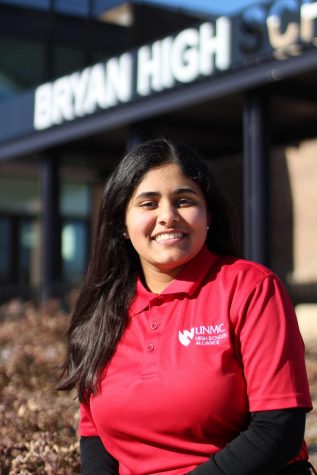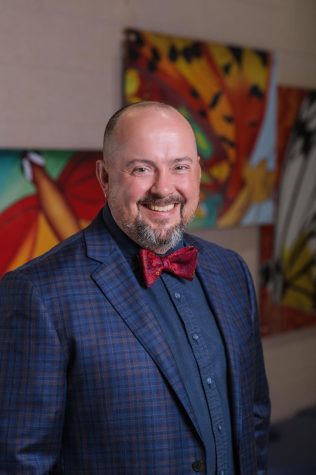STEM program places at State
Math Analysis class uses new tech to teach, create
Senior Samuel Throop watches as senior Galilea Pena-Vilagrana uses a 3D pen for the first time during their math analysis class on Feb. 8. Pena Vilagrana chose to trace a series of curved lines as well as the apple logo on her phone. Their teacher, Charles Cuddy, brought in the pens, which were donated by Nebraska Furniture Mart, as well as stencils of various shapes and designs for the class to experiment with.
February 15, 2019
Creating apps, coming up with ideas to help the community and working with the latest technology is just what students in the school’s Science, Technology, Engineering and Math (STEM) program have been doing. This year, math teacher Charles Cuddy’s Math Analysis class even entered a state contest earning them a fifth-place finish.
Their state project was a tool that would help translate different modes of communication such as posters, easily from English to Spanish. The project was just an idea. The state representative would have gotten a coding expert from Samsung who would have helped with coding and finalizing the project by making an application if they won first place.
“I have had several students mention before that if an email is in English they can translate it easily to Spanish,” Cuddy said, “but when words are overlaid on an image or if they are in a PDF, you can’t.”
In the state competition, Samsung chooses five finalists after looking through all the entries and deciding the most influential ideas. After, Samsung chooses one as the state representative to compete. The National Competition is the same and states show their ideas in front of judges until they are selected as National Finalists.
Cuddy chose to tackle this problem after looking at previous ideas that had placed and going according to Samsung’s rubric. He mentioned how the main goal of Samsung Tomorrow is to bring more exposure to the STEM program while providing a service to the community. With his students being the main assistance in the STEM project they’d have to see how everything goes.
“We saw Mr. Cuddy coding every day and it was very interesting,” senior Mark Lopez said. “Because there are a lot of parents that don’t speak English and the idea of a translator via phone would come in handy not just for them but for everyone.”
And while they had high hopes, Gering High School was chosen as state representative.
“Gering High School won last year,” Cuddy said. “Their project was really cool, and it made sense, since their school focuses on technology and the STEM program.”
Not earning the top spot hasn’t kept the Bears down. They have decided to explore more things in Math Analysis and some have started thinking of new projects for next year.
“Everything has a good or bad impact, but the thought that counts is that we tried,” senior Gage Lukowski said. “In the end I hope that people at least appreciated the idea of what we were trying to do and this opportunity was a great chance.”
To help them on their new projects they have been using instruments not found in most classrooms. The group uses a 3D printer and 3D pens that they received earlier this month to get hands on learning experiences and picture the math structure in real life.
“We just got these new 3D pens and I couldn’t wait to use them in class,” Cuddy said. “The students were excited to use them, and they are really awesome and make you think.”
The class is back to normal curriculum, but they still try out new things in the STEM program.






